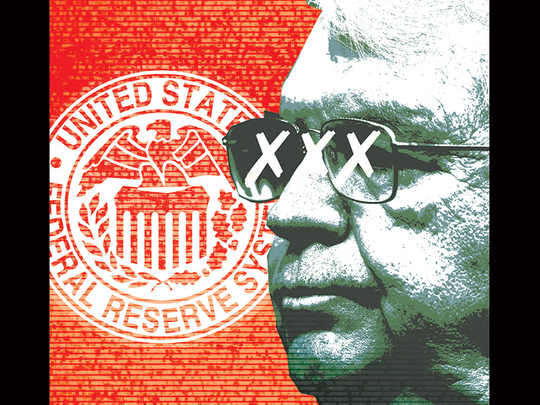
There’s widespread speculation that Stanford University professor John Taylor is being considered by President Donald Trump to replace Janet Yellen as chair of the Federal Reserve in February. Appointing Taylor could be a mistake, both for the Trump administration and the US economy.
Taylor’s academic credentials aren’t in question. He helped develop New Keynesian macro-economics, which is now the main type of macroeconomic theory used by almost all central banks. New Keynesian economics says that a central bank such as the Fed can boost aggregate demand and increase employment by cutting interest rates, but that this will cause inflation to accelerate.
This concept, which is a modification of a classic idea called the Phillips curve, says that the Fed has to engage in a balancing act — keeping interest rates high enough to avoid runaway inflation, but low enough to minimise unemployment. That balancing act is actually written into the Fed’s charter, in the form of the so-called dual mandate.
Taylor proposed that the Fed should walk this tightrope by following a very specific rule, which now bears his name. The Taylor rule says that interest rates should depend on two things — economic output (gross domestic product) and the inflation rate (or, alternatively, the expected future inflation rate).
If the Fed follows the rule, higher expected inflation causes interest rates to rise, while slow growth causes rates to fall — just like New Keynesian theory would suggest.
The Taylor Rule
But that still leaves one question: How much should the Fed worry about inflation versus unemployment? The Taylor Rule contains two numbers that measure how much interest rates respond to each of these economic dangers.
When Taylor made the rule, he rather arbitrarily set both values to be 0.5 — a nice round number — but in fact, they can be anything.
The Fed itself has never officially followed a Taylor-type rule. But when economists examined the Fed’s historical behaviour, they found that the central bank looks as if it’s roughly doing what Taylor prescribed.
The difference is that when compared to the numbers Taylor picked, it looks like the Fed assigns more weight to unemployment and less to inflation.
The Fed’s approach seemed to work fairly well in the 1980s and 1990s. Under Chairman Paul Volcker, it quelled inflation in the early 1980s. The recessions of 1990 and 2001 were relatively mild, possibly thanks to the Fed’s willingness to cut rates.
Only in the Great Recession did this approach seem inadequate — the Fed lowered rates all the way to zero, at which point it could lower them no further (since nominal interest rates can’t go much below zero).
Taylor, however, would have done things differently. In a blog post in June 2011 — when interest rates were at zero and the Federal Reserve was contemplating engaging in further rounds of quantitative easing — Taylor wrote that the Fed ought to raise rates instead: “The Taylor Rule says that the fed funds rate should now be 1 per cent ... So I think the economy would be better off if the Fed started moving to a higher funds rate now rather than later, and I certainly see no rationale for another round of quantitative easing.”
Warning
Taylor’s recommendation relied on his original rule, with its original arbitrary round numbers. That rule recommended raising interest rates above zero as early as 2010, and would have had rates at almost 4 per cent in 2012.
The Fed didn’t take Taylor’s advice. Instead, it kept rates at zero, and continued its programme of QE. Inflation, which Taylor warned about, failed to appear:
Taylor also warned of financial market volatility if interest rates weren’t raised. But that also failed to appear.
Meanwhile, employment began to recover shortly after Taylor’s warning.
So while nobody can say for certain how the Fed’s easy monetary policies affected the economy in 2011 and afterward, it’s safe to say that the outcome was fairly good. And none of the dangers that Taylor prophesied came to pass.
One would think that Taylor would have reconsidered his more hawkish policy rule in light of these developments. But he continued to defend his version of the rule, and to criticise the Fed’s actions, years later.
This apparent refusal to revise his views, combined with a general reputation for monetary hawkishness, probably goes a long way toward explaining why Taylor appeals to the Trump White House.
Extreme conservative circles
Hawkishness is associated with the idea of so-called hard money, an idea that to many of Trump’s generation carries a connotation of toughness and strength. In addition, there is a common idea on the right — especially among the extreme conservative circles from which Trump draws his greatest strength — that inflation represents the government taking money away from virtuous savers and giving it to irresponsible debtors.
As Fed chief, it’s impossible to know in advance if Taylor would live up to these expectations of hawkishness. He’s smart, and he’s not an ideologue — whatever he says at academic conferences, he must surely realise that the Fed’s cautious approach over the last few years looks like a success.
A Taylor-led Fed would inevitably rely on plenty of discretion. But if Taylor did let himself be significantly influenced by the rule that bears his name, it would almost certainly push him to raise interest rates above what other Fed leaders like Yellen might choose.
And that would pose a danger to the real economy.












